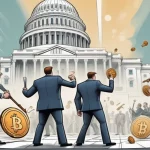SEC’s Hester Peirce Apologizes for Crypto Crackdowns, Hints at NFT Plans

SEC’s Hester Peirce Apologizes for Past Crackdowns, Teases NFT Venture
Hester Peirce, the SEC Commissioner fondly known as “CryptoMom” for her unwavering support of cryptocurrency, delivered a striking mix of remorse and humor in a recent speech at Coin Center. With her official term at the Securities and Exchange Commission (SEC) concluded—though she remains in her role until a successor is named—Peirce reflected on the agency’s turbulent history with digital assets and hinted at quirky plans for her future.
- Peirce’s Next Steps: Lighthearted talk of beekeeping and a “CryptoMom” NFT collection.
- SEC Backlash: Harsh critique of past overreach under Gary Gensler’s leadership.
- Regulatory Shift: Optimism for a softer stance under current SEC head, coupled with a sincere apology.
Peirce’s Apology: A Personal Reckoning
As head of the SEC’s Crypto Task Force, Hester Peirce has long been a beacon for blockchain advocates within a historically hostile regulatory environment. Speaking at Coin Center, with the crypto market cap holding strong at $3.78 trillion (up 0.53% in the last 24 hours), she didn’t shy away from slamming the agency’s past actions under former Chairman Gary Gensler. During his tenure, the SEC pushed hard to classify crypto exchanges and even non-fungible tokens (NFTs) as securities—financial instruments subject to rigorous oversight, akin to labeling a digital collectible as a stock. This aggressive enforcement created a legal minefield for projects, leaving many with no clear path to compliance. For more on her recent reflections, check out her speech details and personal NFT plans.
For those new to the space, NFTs are unique digital assets, often representing art, collectibles, or virtual goods, secured on blockchains like Ethereum. The SEC’s early actions, including bizarre enforcement against projects involving digital cats—yes, “stoned” ones—branded these tokens as securities, crushing innovation in the nascent space. Peirce pulled no punches in her critique:
“Several years ago, the SEC managed to squelch NFTs with some strategic guidance in the form, of course, of an enforcement action: Digital cats, at least stoned ones, and other NFTs were securities. A more sober view of the securities laws now prevails. Chairman Atkins has recently acknowledged that most digital assets are not securities.”
This marks a significant pivot under current Chairman Atkins, whose more balanced perspective offers a stark contrast to Gensler’s iron-fisted approach.
SEC’s Shift: From Hostility to Hope
Beyond mere criticism, Peirce’s speech carried a deeply personal tone. She issued a heartfelt apology to the crypto community for the SEC’s restrictive policies during much of her tenure.
“I am sorry that over most of my tenure at the SEC I failed to convince my colleagues in government to give you a chance. I hope that you and others whom you have inspired will use this time—a time in which regulatory clarity has replaced ambiguity as government’s objective—to build good things that will enhance the safety, security, happiness, and prosperity of your family, friends, neighbors, and nation. Show the skeptics that technologies that enable us to engage permissionlessly and privately with our peers are worth preserving and celebrating.”
This isn’t just regret—it’s a call to arms for developers and users to capitalize on emerging regulatory clarity and prove the value of blockchain tech.
Permissionless systems, a core ethos of Bitcoin and many decentralized protocols, mean anyone can participate without needing approval from a central authority. Think of sending Bitcoin like sending an email—no bank or government can block it, unlike traditional finance where intermediaries often interfere. Peirce’s advocacy for such freedom aligns with her vision of tech empowering individuals, not shackling them. Her words also highlight a brutal reality: years of regulatory uncertainty under Gensler’s SEC cost the U.S. dearly, driving talent and capital to crypto-friendly hubs like Singapore, with its clear licensing frameworks, or Switzerland’s Zug, dubbed “Crypto Valley” for its progressive laws. This lag in U.S. crypto innovation is a gap she hopes can now narrow.
Regulatory Clarity: What It Means for Crypto
Under Chairman Atkins, regulatory clarity seems to be taking shape, though specifics remain sparse. Unlike Gensler’s era—marked by high-profile lawsuits against exchanges like Coinbase and Binance, alongside millions in fines and forced market exits—Atkins’ acknowledgment that most digital assets aren’t securities signals a potential reset. While concrete guidelines are yet to emerge, whispers of frameworks distinguishing between utility tokens, stablecoins, and investment vehicles are circulating. For Bitcoin, often seen as a store of value rather than a speculative asset, this could solidify its position as untouchable by securities laws. Altcoins like Ethereum, with more complex use cases around smart contracts, might face nuanced rules but still benefit from less hostility.
Yet, let’s not get carried away with optimism. Clarity is a step, not a cure. The crypto space still wrestles with internal demons—scams, hacks, and speculative bubbles that tarnish its reputation. Take the countless rug pulls in DeFi or NFT projects where founders vanish with investor funds. Regulatory leniency won’t fix these; it’s on the community to build trust through real utility. Peirce’s challenge to “show the skeptics” isn’t just about tech—it’s about integrity. Can we prioritize solutions over hype? Bitcoin’s immutable ledger and proof-of-work design embody the decentralized ideals she champions, while some centralized altcoins or stablecoins might not align as neatly with her vision of privacy and autonomy.
A Deeper Look at SEC History and Peirce’s Dissent
To grasp the weight of Peirce’s apology, consider the SEC’s track record under Gensler. Beyond absurd overreach on digital cats, the agency targeted major players, slapping Coinbase with a lawsuit over unregistered securities and pressuring Binance.US to the brink of operational collapse. These actions weren’t just slaps on the wrist—fines reached tens of millions, and the chilling effect pushed startups offshore. Peirce, often a lone voice of dissent, publicly opposed such moves. Notably, she criticized the SEC’s 2020 rejection of Bitcoin ETFs as overly cautious, arguing the market was mature enough for such products—a stance vindicated years later with approvals. Her consistent pushback cements her credibility as a true ally to the space, making her regret all the more poignant.
Playing devil’s advocate, though, is her apology more symbolic than impactful? Internal SEC politics and external pressures—think lobbying from traditional finance—could still derail progress. Even with Atkins’ softer tone, bureaucratic inertia or sudden policy reversals remain risks. The crypto community can’t bank solely on regulatory goodwill; resilience through decentralized design, especially Bitcoin’s unassailable network, must be the bedrock. As Bitcoin maximalists, we see this clarity disproportionately favoring BTC as a censorship-resistant (meaning transactions can’t be blocked by governments or corporations) store of value over speculative altcoins, though we recognize Ethereum and others fill vital niches in this financial revolution.
CryptoMom’s Next Act: Humor or Hint?
On a lighter note, what’s next for Commissioner Peirce as she awaits her replacement? During her Coin Center address, she tossed out playful ideas for post-SEC life. Beekeeping might offer a quiet escape from the regulatory buzz, but her suggestion of launching a “CryptoMom” NFT collection stole the show. Envisioned with 18 characters inspired by crypto personalities—one likely a pixelated Peirce wielding a gavel—it’s a cheeky nod to NFTs’ journey from SEC targets to cultural icons. While almost certainly a jest, it underscores a serious shift: digital assets are no longer just regulatory punching bags but symbols of creativity and ownership. Her humor doubles as a bridge to the community, showing she gets the cultural pulse of blockchain beyond dry policy debates.
Key Questions and Takeaways on Hester Peirce’s SEC Apology and Crypto’s Future
- Why did Hester Peirce apologize to the crypto community?
She expressed deep regret for failing to shift the SEC’s hostile stance on digital assets during her tenure, recognizing how past overreach under Gary Gensler stifled innovation. - How has SEC crypto regulation evolved under Chairman Atkins?
Unlike Gensler’s aggressive enforcement, Atkins acknowledges most digital assets aren’t securities, offering a more balanced view that could ease legal fears for blockchain projects. - What does regulatory clarity mean for Bitcoin and blockchain innovation?
Clearer rules reduce the risk of lawsuits, freeing developers to build secure, permissionless systems like Bitcoin while fostering trust across the broader crypto ecosystem. - How did past SEC actions impact U.S. crypto growth?
Harsh policies drove talent and capital to friendlier hubs like Singapore and Switzerland, costing the U.S. years of leadership in blockchain tech—a gap Peirce hopes can now close. - Was Peirce serious about a CryptoMom NFT collection?
Likely a joke, but it reflects NFTs’ cultural rise and shift from SEC targets to accepted digital assets, symbolizing evolving regulatory attitudes. - Can the crypto industry prove skeptics wrong with this newfound clarity?
Peirce challenges the community to build real utility—especially with Bitcoin’s decentralized ethos—rather than fueling speculative bubbles or scams that damage credibility.
Hester Peirce’s blend of apology, advocacy, and wit offers a rare glimpse into the SEC’s evolving dance with digital assets. Her words are both a reckoning of past failures and a hopeful nudge toward a freer, decentralized future. As champions of Bitcoin, we applaud her defense of permissionless tech, while acknowledging altcoins like Ethereum carve out their own indispensable roles. The question lingers: will the crypto community seize this moment to build trust and substance, or fall back into old traps of hype and fraud? The ball is in our court—let’s not fumble it.



